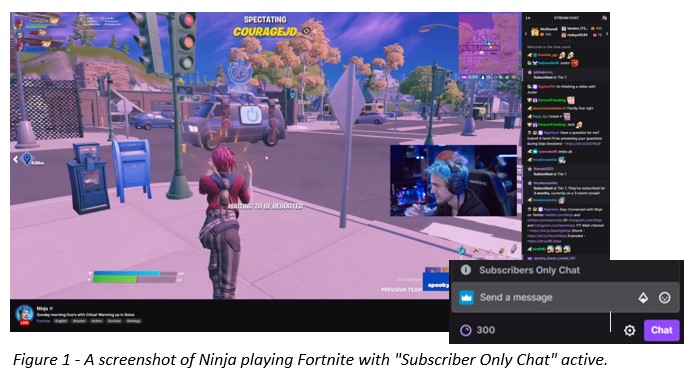Streaming on sites such as Twitch, YouTube, and Facebook has become more prevalent over the past few years as shown through research done by Wulf et al. (2020) titled “Watching players: An exploration of media enjoyment on Twitch” and by Taylor (2018) titled “Twitch and the work of play”. These articles touch on the two different perspectives of being a viewer and being a producer of gaming streams. I observed three streamers, Zizaran, Ninja, and GernaderJaker, to explore the important points raised in the articles.
From a viewer perspective, some points mentioned by Wulf et al. (2020) were immediately evident. The authors mentioned how the relationship between a streamer and their viewers is equivalent to a “virtual friendship” (Wulf et al., 2020). The interactions across these streams were very supportive of this concept as Zizaran and GernaderJake were constantly involved with their chat by continuing conversations with users instead of simply answering their questions and moving on. Ninja interacted with chat in a different way as his chat was limited to only those who subscribe to his stream. The users chatting were interacting with each other and were asking questions relating to the game which also supports the research done by Wulf et al. (2020) relating to streams being a community which presents a “unique digital learning paradigm” between streamers and viewers.

Zizaran’s and GernaderJake’s channels provided a digital community as also presented by Wulf et al. (2020). These viewers were interacting with each other and asking questions about the game that the streamers were playing. In some instances, the viewers were even making plans to meet up in their respective games to partake in the same activities that the streamers were doing at the time. Not all streams seemed to have the same level of viewer-to-viewer interaction. Zizaran and GernaderJake, who both actively participated with the chat, had a community in which there were a lot more discussions in the chat. Ninja, who rarely participated with the chat, had less discussions amongst users in his chat.
The enjoyment factor of suspense mentioned by Wulf et al. (2020) was evident during all three streams. GernaderJake and Ninja were playing competitive shooters, Destiny 2 and Fortnite respectively, and were facing-off against other players in player-verse-player modes. Chat was very active in GernaderJake’s channel as they reacted live to the outcomes of matches. Zizaran was playing Terraria and going through the game to defeat certain bosses as his chat gave him advice to progress through the game. The chat showed empathy and advice the few times that Zizaran failed at the boss and shared in the excitement and celebration when he was finally able to defeat it.

From the streamer perspective of production, all three channels showed a true balancing act being performed by the streamers. Their material and digital infrastructure and set design, both through virtual overlay and their physical backgrounds, were very impressive and added to the quality of the stream. GernaderJake’s channel featured notifications that would show anytime someone subscribed or donated, and he had a notification bar on the top as a “leaderboard” relating to donations. The background of his streaming set was also impressive with the use of his channel brand “Jungle Squad” in LED lights along with his channel icon imprinted on the glass of his computer case. If a viewer had questions about the specific mouse or microphone he was using, he would direct them to a YouTube video in which he goes over all his streaming equipment.

As discussed by Taylor (2018), streamers tend to take on an “entertaining persona” to captivate the viewers. To achieve this, streamers normally will talk through their actions as they play and critique the game and their own performance. All three streamers continuously spoke while playing and helped provide viewers the ability to learn from their successes and mistakes. Ninja spoke through communication with his teammates which helped provide reasoning for his actions, while Zizaran spoke through the actions he was taking as a “checklist” before going to a boss.
All three streamers had very distinct economic and commercial frameworks as mentioned by Taylor (2018). GernaderJake’s overlay featuring the leaderboard mentioned prior was a prime example of his framework. Furthermore, his channel points (points which automatically are accumulated through view time on his stream) are a large factor of his channel. These channel points can be spent to enter raffles to play with GernaderJake and entice the viewer to come back to continue to accumulate the points with the hope of eventually playing with him. This allows GernaderJake is maintain a consistently high view count which is important for ad revenue and potential sponsorships with companies.
The points raised in the articles by Taylor (2018) and Wulf et al. (2020) were very evident during my time viewing streams on Twitch. Streamers must constantly be balancing playing the game, having discussions with your chat, and acting in a way to foster a positive community. A Twitch channel acts as a virtual community for viewers where they can make new friends and learn from each other and the streamer. The future of streaming is bright as the barrier to entry is low, but only the streamers who are successfully able to entice their viewers and form a virtual friendship will be able to succeed.
References
Taylor, T. L. (2018). Twitch and the work of play. American Journal of Play, 11(1), 65-84.
Wulf, T., Schneider, F. M., & Beckert, S. (2020). Watching players: An exploration of media enjoyment on Twitch. Games and Culture, 15(3), 328-346. https://doi.org/10.1177/1555412018788161






